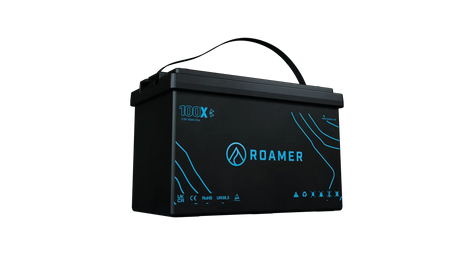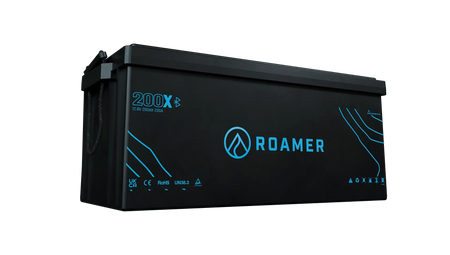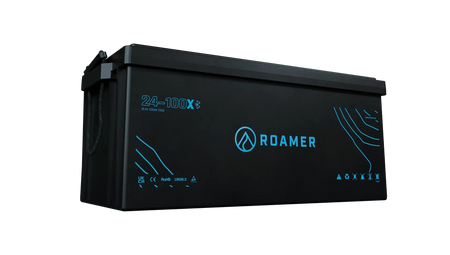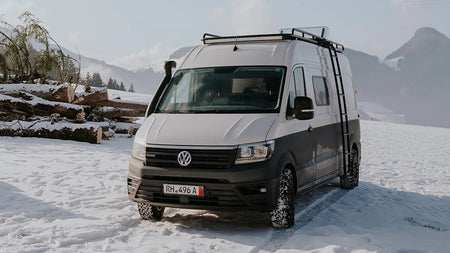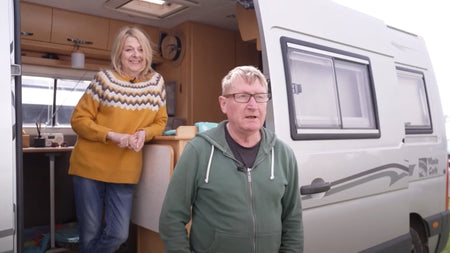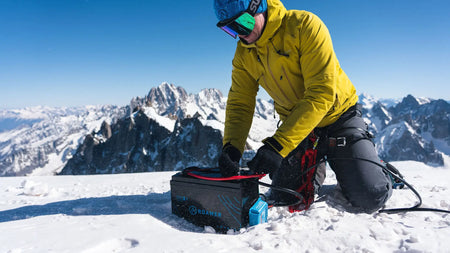
A guide for maintaining your lithium battery in cold temperatures
Some of the most popular questions we get asked about our batteries relate to low temperature charging. It’s not surprising there is so much confusion as there is very little genuine information out there to help!
Thankfully, Winter vanlife and lithium batteries are our specialist subjects! Kate and I spend several weeks in our campervan every winter, touring the ski resorts of the Alps. We’ve also got a resident Arctic expert in Alex Frood; Roamer’s system designer has spent the last 3 winters north of the Arctic circle, searching out the coldest places on the planet in his camper, so far his record is an incredible minus 37!

First, let's dispel with a few common myths
Myth number 1: Lithium batteries do not work below 0 degrees.
FALSE! LiFePO4 batteries actually perform way better than lead acid batteries in the cold. You can discharge down to minus 20 degrees at high current with minimal loss of capacity, unlike lead acid which can lose as much as 90% of its useable capacity at low temperatures.
Myth number 2: Lithium batteries cannot be charged at sub-zero temperatures
FALSE! LiFePO4 batteries can be charged at any temperature but as it gets colder, you should reduce the charge current accordingly. When it gets below 0C then its still possible to charge at low amps but unless you have a fail-safe method of limiting charge current, it’s better to stop charging altogether. This is why we include low temperature charge protection as standard on all our batteries.
Myth number 3: Heating the battery cells is a safe method of allowing charging at low temperatures
FALSE! Heating lithium cells directly (via heat film or a heat pad) is potentially one of the most damaging things you can do to your battery. We have tested this extensively and the conclusions were clear - cell heaters leads to uneven cell temperatures and can trick the BMS into allowing charging before its ready. This is why we do not include heating in our batteries.

So why does everyone say lithium batteries don't like the cold?
All batteries are based on a chemical reaction and as such, performance is inhibited by lower temperatures. Lead acid batteries lose significant amounts of useable capacity and it can be a lot more difficult to charge them. But where lead acid are only affected temporarily, charging LiFePO4 at very low temperatures can permanently damage the cells. This due to a chemical process called lithium plating that occurs when charge current is higher than it can cope with. In serious cases, this can lead to internal short circuits and potentially even thermal runaway. As the temperature drops, this acceptable charge current drops, and below zero it is low enough that its safer to just not charge them at all.
Roamer batteries therefore include a low temperature charge protection function in the BMS which will prevent you charging once the internal battery temperature drops below 0°C. This protection will remain in place until the temperature rises back above 5°C (this buffer is there to allow time for the whole battery cell pack to warm up).
Now being realistic, if your campervan is below zero while camping then you’re either a much hardier camper than I am, or you’ve got bigger problems going on than missing out on a few watts of solar charging! So really this is only a potential issue if you leave your battery connected and it is allowed to run flat while its in storage - if this happened and you returned to the battery when its very cold, you would be left with a flat battery that you wouldn't be able to charge until it warmed up.
What to do if your battery is in low temperature charge protection mode?
If you find your battery has got so cold that the low temperature protection has kicked in, there are a few easy ways to handle this. First of all, remember that this ONLY affects charging. You can discharge down to minus 20 degrees without any issues so as long as you have a bit of remaining battery capacity, you can simply run your heater and allow the battery to slowly come back up to temperature. The chemical reaction that occurs when discharging will also warm the cells up from the inside-out so this will help speed up the process.
It’s important that the battery is allowed to come back up to temperature SLOWLY. Inside your battery are several large cells, up to 5kg each and 7cm thick. These will take a long time to warm up all the way through so you might need to leave your heater on for 8-10 hours. When the protection is released, it is better if you charge at low currents until it warms further, then you can charge normally.

How to install your battery correctly to prevent problems
We recommend you install your battery in the heated living space of your campervan or boat. If you want to install in the engine bay, outside locker or other exposed area then we recommend using the Roamer XTREME battery instead as this can be charged down to minus 30 without any issues.
It’s important that the battery temperature is consistent across all cells. If you install the battery on a bare metal floor, this will result in cold bridging from the floor to the bottom of the battery. We therefore recommend fitting the battery with an air gap or thick insulation underneath in order to protect against this cold bridging.
It is a good idea to have a heater vent in the general area of the battery compartment but avoid blasting it directly with heat. You want the battery to warm slowly by heating the space around the battery.
Heat pads and self-heated batteries
Due to the size and bulk of the battery cells, it can take several hours for the internal temperature to match the ambient temperature, and for all cell temperatures to equalise. If you need to warm the battery to enable charging, then gently heat the air around the battery, not the battery itself.
Applying heat directly to the cells (via internal heating) or to the battery case causes premature ageing of the battery cells and lithium plating, by warming the outer surface of the cells above the BMS protection threshold whilst leaving the core of the cell at unsafe charging temperatures. Imagine your battery is a giant frozen turkey - cell heaters are the equivalent of trying to defrost it in a frying pan, it just doesn't work.
We stripped down and tested a self-heated battery to show how this works (or doesn't in this case). You can watch the video here

Reduce charge current according to temperature
To maintain a long and healthy life for your battery and to minimise safety risks, you should also reduce charge currents according to the battery temperature. Please pay attention to the recommended charge currents given below. Remember, it is not a bucket of water that freezes at 0 degrees and its not as simple as charging above 0 = good and charging below 0 = bad. Fast charging a battery at 1 degree is a lot more damaging than slow charging a battery at 0 degrees! Please refer to the user manual for the correct charge currents for your battery model, at different temperatures.
